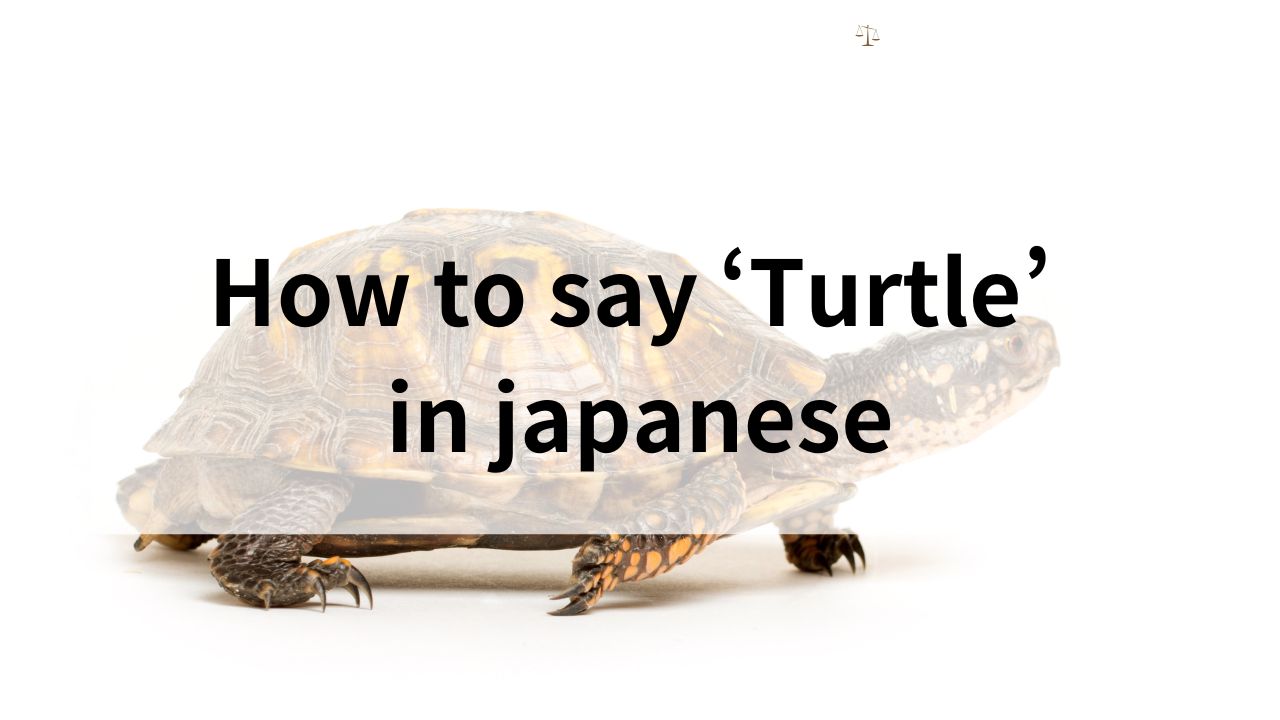Are you curious about how to say “turtle” in Japanese? Turtles hold a significant place in Japanese culture and language, symbolizing longevity, luck, and wisdom. This guide will explore the Japanese word for “turtle,” its cultural meanings, and practical applications.
How Do You Say “Turtle” in Japanese?
The Japanese word for “turtle” is カメ (Kame). It’s a simple and widely recognized term used in both casual and formal contexts. The kanji for turtle is 亀, but it’s less commonly used in everyday conversation compared to its katakana or hiragana forms.
The Japanese Word for Turtle: Kame (カメ)
“Kame” is used to describe turtles in general and appears in various phrases and contexts. For example:
- カメが泳いでいる (Kame ga oyoideiru): “The turtle is swimming.”
- カメを飼う (Kame o kau): “To keep a turtle as a pet.”
- 海ガメ (Umi-game): “Sea turtle.”
Kanji for Turtle: 亀
The kanji for turtle, 亀, is often seen in literature or traditional contexts. While the kanji may seem formal or complex, it carries cultural and symbolic weight in Japanese traditions.
Does Saying “Turtle” Work in Japan?
Using the English word “turtle” may not be universally understood in Japan, especially in non-urban areas. It’s best to use the Japanese term “kame” (カメ) to ensure clear communication.
The Cultural Significance of Turtles in Japan
Turtles have been revered in Japan for centuries, symbolizing longevity, wisdom, and good fortune. They appear in mythology, art, and festivals, reflecting their deep cultural significance.
Turtles as Symbols of Longevity and Luck
In Japanese culture, turtles are often associated with longevity due to their long lifespans and slow, steady movements. They are considered auspicious creatures, bringing good luck and prosperity.
Turtles in Japanese Folklore and Mythology
Turtles frequently appear in Japanese folklore, such as the famous story of Urashima Tarou, where a turtle guides the protagonist to an underwater palace. This story highlights the turtle’s role as a wise and mystical creature.
Turtles in Japanese Art and Festivals
Traditional Japanese art often features turtles, emphasizing their symbolism of stability and endurance. Some regional festivals celebrate turtles as protectors of local waters and ecosystems.
Practical Applications of “Turtle” in Japanese
Learning how “turtle” is used in Japanese can help you navigate conversations, understand idioms, and recognize its presence in Japanese culture.
Talking About Turtles in Daily Conversation
Here are some examples of how “kame” is used in everyday conversation:
- カメが好きです (Kame ga suki desu): “I like turtles.”
- カメの種類を調べる (Kame no shurui o shiraberu): “Research different types of turtles.”
Turtle-Related Idioms or Expressions
Turtles are featured in several Japanese idioms and expressions, reflecting their cultural significance as symbols of longevity, wisdom, and perseverance. Here are some common examples:
- 鶴は千年、亀は万年 (Tsuru wa sennen, kame wa mannen): “A crane lives a thousand years, a turtle ten thousand years.” This proverb symbolizes longevity and is often used to convey good wishes or describe someone’s long life.
- 亀の甲より年の功 (Kame no kou yori toshi no kou): “Experience is better than a turtle’s shell.” This saying emphasizes the value of experience and the wisdom that comes with age.
- 亀の歩み (Kame no ayumi): “A turtle’s pace.” This idiom is used to describe slow but steady progress, often with a positive connotation of persistence.
- 亀の甲羅に水 (Kame no koura ni mizu): “Water on a turtle’s shell.” This phrase indicates that something has no effect, similar to “water off a duck’s back” in English.
- 亀の子 (Kame no ko): Literally “turtle’s child,” but also refers to the traditional Japanese scrubbing brush called “kame no ko tawashi,” reflecting its cultural significance in everyday life.
These idioms highlight the cultural and metaphorical richness of turtles in Japanese thought and language. Learning them can provide deeper insights into Japanese values and communication.
Common Types of Turtles in Japan
In Japan, the word “kame” (カメ) generally refers to small, swimming turtles, such as the popular ミドリガメ (Midori-game, Red-Eared Slider) or ゼニガメ (Zeni-game, baby turtles). Larger species like land turtles and sea turtles have more specific terms:
- リクガメ (Riku-game): Land turtles or tortoises.
- ウミガメ (Umi-game): Sea turtles.
- ミドリガメ (Midori-game): The most common pet turtle in Japan, known for its greenish shell.
When discussing turtles in Japan, it’s helpful to use these specific terms to clarify which type of turtle you are referring to. Simply saying “kame” might be interpreted as a small, common turtle unless the context makes it clear.
Turtles in Japanese Cuisine or Products
Although less common in modern Japan, turtles have been historically used in traditional dishes like soup. Turtles also appear in souvenirs and decorative items, symbolizing luck and prosperity.
FAQs
Here are some frequently asked questions about turtles in Japanese culture and language.
Are Japanese Turtles Different From Western Turtles?
Yes, Japan is home to unique turtle species, such as the Japanese pond turtle (Mauremys japonica). These turtles are often smaller and adapted to Japan’s specific environment.
How Do You Write “Turtle” in Japanese?
You can write “turtle” as カメ (Kame) in katakana, かめ (Kame) in hiragana, or 亀 in kanji. The choice of script depends on the context and formality.
Conclusion
Turtles, or “kame” in Japanese, are more than just animals—they are symbols of longevity, luck, and cultural significance. By understanding their role in Japanese language and traditions, you can deepen your appreciation for these fascinating creatures and their place in Japanese society.








